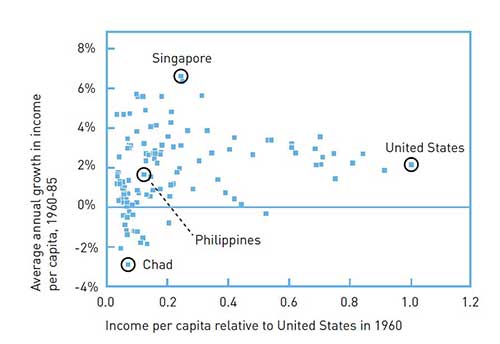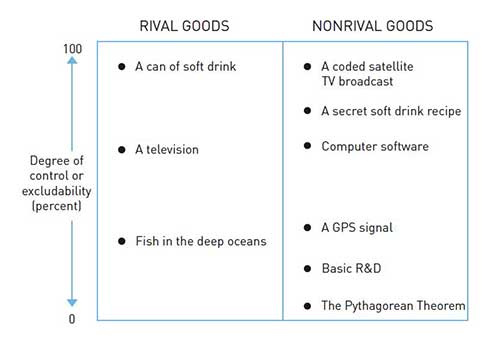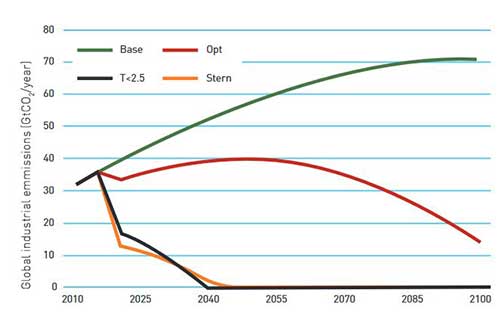Popular information
Popular science background:
Integrating nature and knowledge into economics (pdf)
Populärvetenskaplig information:
Kunskap, ekonomi och klimat i växelverkan (pdf)

The Prize in Economic Sciences 2018
This year’s Prize in Economic Sciences rewards the design of methods that address some of the most fundamental and pressing issues of our time: long-run sustainable growth in the global economy and the welfare of the world’s population.
Integrating nature and knowledge into economics
The study of how humanity copes with limited resources is at the heart of economics and, since its inception as a science, economics has recognised that the most important constraints on resources reflect nature and knowledge. Nature dictates the conditions in which we live and knowledge defines our ability to manage these conditions. However, despite their central role, economists have generally not studied how nature and knowledge are affected by markets and economic behaviour. This year’s laureates, Paul M. Romer and William D. Nordhaus, have broadened the scope of economic analysis by designing the tools that are necessary to examine how the market economy has a long-term influence on nature and knowledge.

The work of both Laureates builds upon the Solow growth model, which received the Prize in Economic Sciences in 1987.
Knowledge For more than a century, the overall global economy has grown at a remarkable and fairly steady pace. When a few per cent of economic growth per year accumulates over decades and centuries, it transforms people’s lives. However, growth has progressed much more slowly throughout most of human history. It also varies from country to country. So what explains when and where growth occurs? Economics’ conventional answer is technological change, where the growing volumes of knowledge are embodied in technologies created by inventors, engineers, and scientists. In the early 1980s, when he was a PhD student at the University of Chicago, Paul Romer started developing the theory of endogenous growth, where technological advances do not just flow in from external – exogenous – sources, as assumed in earlier economic models. Instead, they are created by purposeful activities in the marketplace. Romer’s findings allow us to better understand which market conditions favour the creation of new ideas for profitable technologies. His work helps us design institutions and policies that can enhance human prosperity by fostering the right conditions for technological development.
Nature William Nordhaus began his work in the 1970s, after scientists had become increasingly concerned about how the combustion of fossil fuels causes serious global warming, and the detrimental effects of such climate change. Nordhaus took on the daunting task of examining bidirectional feed-back loops between human activity and the climate, combining basic theories and empirical results from physics, chemistry, and economics. He thus not only regarded nature as a constraint on human activity, but also as something greatly influenced by economic activity. Nordhaus became the first person to design simple, but dynamic and quantitative models of the global economic-climate system, now called integrated assessment models (IAMs). His tools allow us to simulate how the economy and climate would co-evolve in the future under alternative assumptions about the workings of nature and the market economy, including relevant policies. His models address questions about the desirability of different global scenarios and specific policy interventions.
Imperfections in the global market Both laureates highlight spillover effects on society, which are consequences for others that were not taken into account by individual innovators or polluters. Any idea for a new technology, wherever it originates, can be used for the production of new goods and other ideas in any other place, now or in the future. Similarly, a newly emitted unit of carbon, whatever its origin, quickly diffuses in the atmosphere and contributes to climate change, affecting all of humanity now and in the future. Economists refer to these types of spillover effects as externalities. The externalities studied by Romer and Nordhaus have global reach and long-term consequences. As unregulated markets will generate inefficient outcomes in the presence of such externalities, the work of Romer and Nordhaus provides convincing arguments for government intervention.
Technological innovation
Motivation Long-term differences in growth rates have staggering consequences when they occur. If two economies start out with equal GDP per capita, but one grows at a 4 per cent higher rate, it will become almost five times richer in 40 years. A more modest 2 per cent growth advantage translates into twice as much national income in 40 years.

Romer’s research shows how the accumulation of ideas sustains long-run economic growth.
In the late 1980s, Romer observed that the income growth rates in actual data vary greatly from country to country. Figure 1, based one of Romer’s papers, depicts income per capita in 1960 and the average growth for the subsequent 25 years for over 100 countries; a graph with contemporary data looks virtually identical. Each square represents a country. As the figure shows, typical growth-rate differences between countries were several percentage points, and there is a huge gap – around ten percentage points – between the fastest and slowest growing countries. Moreover, the figure shows no systematic relationship between initial income and growth: some poor countries grow rapidly, while others actually shrink. Romer concluded that understanding the causes of such persistent and significant growth-rate differences is crucially important, and started looking for an explanation.

Figure 1: Income per capita (relative to the US) in 1960 for over 100 countries (horizontal axis) and subsequent average annual growth in income for 1960-85 (vertical axis). Each square represents a country. Data from Robert Summers and Alan Heston.
Empirical and theoretical shortcomings As Romer noted, the dominant growth theory at the time – the Solow growth model, which received the Prize in Economic Sciences in 1987 – could explain many features of economic growth, but not large and persistent differences in growth rates. The Solow model predicts that poorer countries should grow faster and catch up with richer ones quite quickly, which is not what Figure 1 shows. In the model, an economy can grow by accumulating physical capital, for example machines or infrastructure, but capital-driven growth must peter out in the longer term; for any given technology, adding more capital yields less and less additional output. To allow for persistent long-run growth (and growth differences) in the model, the assumption has to be that, over time, labour becomes increasingly productive due to technological advances, although at varying rates for each country. Therefore, the Solow model does not explain these trends, because changes in technology simply arrive exogenously from a “black box”.
A major breakthrough Romer’s biggest achievement was to open this black box and show how ideas for new goods and services – produced by new technologies – can be created in the market economy. He also demonstrated how such endogenous technological change can shape growth, and which policies are necessary for this process to work well. Romer’s contributions had a massive impact on the field of economics. His theoretical explanation laid the foundation for research on endogenous growth and the debates generated by his country-wise growth comparisons have ignited new and vibrant empirical research.
What’s special about ideas-driven growth? To answer that question, we must understand how ideas are different to goods such as physical or human capital. Romer taught us to think about goods using two dimensions, as in Figure 2.
In the first dimension, physical and human capital are rival goods. If a particular machine, or a trained engineer, is used in one factory, the same machine or engineer cannot be used at the same time in another factory. Ideas, on the other hand, are non-rival goods: one person or firm using an idea does not preclude others from using it too.
In the second dimension, these goods may be excludable if institutions or regulations make it possible to prevent someone from using them. For some ideas, such as results from basic research, this is difficult or even impossible – think about mathematical insights like the Pythagorean Theorem.
For other ideas, however, users can be excluded through technical measures (such as encryption) or patent laws. Romer’s breakthrough article showed how the rivalry and excludability of ideas determine economic growth.

Figure 2: Rival and excludable goods
Romer believed that a market model for idea creation must allow for the fact that the production of new goods, which are based on ideas, usually has rapidly declining costs: the first blueprint has a large fixed cost, but replication/reproduction has small marginal costs. Such a cost structure requires that firms charge a markup, i.e. setting the price above the marginal cost, so they recoup the initial fixed cost. Firms must therefore have some monopoly power, which is only possible for sufficiently excludable ideas. Romer also showed that growth driven by the accumulation of ideas, unlike growth driven by the accumulation of physical capital, does not have to experience decreasing returns. In other words, ideas-driven growth can be sustained over time.
Market imperfections and policy In principle, the new knowledge created by successful research and development, R&D, can benefit entrepreneurs and innovators anywhere in the world, now and in the future. However, markets generally do not fully reward the creators of new knowledge for the full benefits of their innovations, which means that – as long as the new knowledge is socially beneficial – too little R&D is conducted. Furthermore, as market incentives for R&D come in the form of monopoly profits, there will typically be inadequate provision of new goods once they have been invented. Subsequent research has shown how market outcomes may also entail too much R&D – either when new ideas kill off too many existing firms in a process of creative destruction, or when new ideas augment socially harmful technologies, such as by enabling excessive extraction or use of fossil fuels, thus harming the climate.
To summarise, Romer showed that unregulated markets will produce technological change, but tend to underprovide R&D and the new goods created by it. Addressing this under-provision requires well-designed government interventions, such as R&D subsidies and patent regulation. His analysis says that such policies are vital to long-run growth, not just within a country but globally. It also provides guidelines for policy design: patent laws should strike the right balance between the motivation to create new ideas, by giving some monopoly rights to developers, and the ability of others to use them, by limiting these rights in time and space.
Climate change
Human activity has contributed to the rapid increases in average global temperatures over the last 100 years. While there is uncertainty about the extent to which this will affect the climate in the future, natural scientists have reached a clear consensus that this is “in all likelihood, very significantly”.

Nordhaus’ research shows how economic activity interacts with basic chemistry and physics to produce climate change.
Motivation In the 1970s, when he was a young faculty member at Yale University, William Nordhaus keenly studied the emerging evidence on global warming and its likely causes and concluded that he had to do something. His concern was channelled into devising new tools to help us understand how the economy can generate climate change, as well as the societal consequences of climate change. He wanted to develop a framework that allowed climate change to be analysed in terms of costs and benefits.
A tall order Like Romer, Nordhaus extended the Solow growth model with an important set of spillover effects by including the global warming caused by carbon emissions. In this case, the relevant spillovers are predominantly negative. Crucially, the specific mechanisms and drivers of humaninduced climate change involve processes studied in the natural sciences. A global analysis of climate change thus requires a truly integrated approach, in which society and nature dynamically interact. Recognising the need for such an approach, Nordhaus pioneered the development of integrated assessment models (IAMs). His models have three interacting modules:
A carbon-circulation module This describes how global CO2 emissions influence CO2 concentration in the atmosphere. It reflects basic chemistry and describes how CO2 emissions circulate between three carbon reservoirs: the atmosphere; the ocean surface and the biosphere; and the deep oceans. The module’s output is a time path of atmospheric CO2 concentration.
A climate module This describes how the atmospheric concentration of CO2 and other greenhouse gases affects the balance of energy flows to and from Earth. It reflects basic physics and describes changes in the global energy budget over time. The module’s output is a time path for global temperature, the key measure of climate change.
An economic-growth module This describes a global market economy that produces goods using capital and labour, along with energy, as inputs. One portion of this energy comes from fossil fuel, which generates CO2 emissions. This module describes how different climate policies – such as taxes or carbon credits – affect the economy and its CO2 emissions. The module’s output is a time path of GDP, welfare and global CO2 emissions, as well as a time path of the damage caused by climate change.
A global dynamic system The three modules form a simple, but dynamically interactive model of the world. There are two versions of Nordhaus’ model: the Regional Integrated Climate-Economy (RICE) model, in which the economic-growth module has eight separate regions, and the simplified Dynamic Integrated Climate-Economy (DICE) model, where that module has a single region. Nordhaus’ IAMs can be used to simulate the consequences of business-as-usual policies or those of various policy interventions. The models are also helpful in evaluating how to guide the market economy towards emission levels that properly balance societal costs and benefits. This question cannot be addressed without a model in which – as in reality – humans are affected by the climate at the same time as the climate is affected by humanity’s economic activities.
Policy recommendations According to Nordhaus’ research, the most efficient remedy for the problems caused by greenhouse gas emissions would be a global scheme of carbon taxes that are uniformly imposed on all countries. This recommendation builds upon a result formulated in the 1920s by a British economist, A.C. Pigou, namely that each emitter should pay the societal cost of the damage caused by their emissions via an appropriate price. A global emission trading system can do the same job, provided that limits on emissions are set low enough to result in a high enough price for carbon.
However, IAMs do not just provide qualitative results. Crucially, they allow us to calculate quantitative paths for the best carbon tax, and show how these paths depend on assumptions about parameters: e.g. how sensitive global temperature is to the concentration of carbon in the atmosphere, how long it remains in the atmosphere, and the extent of the damage caused by climate change. A recent study by Nordhaus is a useful illustration of how an IAM can be employed to analyse policy. He simulates four policies in the latest version of DICE, using best-guess estimates for climate change parameters:

Figure 3: CO2 emissions over time for four climate policies (explanations in the text). Predictions from the DICE-2016R2 model, according to Nordhaus’ own simulations.
1. Base: no new climate change policies beyond those in place in 2015.
2. Opt: carbon taxes that maximise global welfare, using conventional economic assumptions about the importance of the welfare of future generations.
3. Stern: carbon taxes that maximise global welfare, with substantially more empha- sis on the welfare of future generations than in scenario 2, as suggested in The Economics of Climate Change: The Stern Review, from 2007.
4. T < 2.5: carbon taxes high enough to keep global warming from ever exceeding 2.5°C are implemented at minimum global welfare cost.
Huge uncertainties In both the natural sciences and the social sciences, there are uncertainties about many aspects of climate change. For example, we do not know exactly how sensitive the climate is to greenhouse gas emissions, or how great the risk is of passing global tipping points beyond which the climate may spiral out of control. Similarly, we have incomplete knowledge about the economic and human damages caused by climate change and about the cost of de-carbonisation. Naturally, the IAMs developed by Nordhaus cannot eliminate this uncertainty. However, his models can analyse how the appropriate pricing of carbon is affected by different possibilities, such as higher climate sensitivity or the higher probability of a dangerous global tipping point at 2°C of warming.
Exciting research agendas Paul Romer’s and William Nordhaus’ contributions are crucial steps forward in addressing central questions about the future of humanity. We do not yet have conclusive answers to these questions, but the laureates’ methods have been fundamental in allowing current and future researchers to improve our understanding of the best way to progress towards sustained and sustainable global economic growth.
Links and further reading
Additional information on this year’s prizes, including a scientific background in English, is available on the website of the Royal Swedish Academy of Sciences, www.kva.se, and at http://www.nobelprize.org. There, and at www.kva.se/video, you can watch video footage of the press conferences, the Nobel Lectures and more. Information on exhibitions and activities related to the Nobel Prizes and the Prize in Economic Sciences is available at www.nobelcenter.se.
Books
Nordhaus, W.D. (2015) the Climate Casino: Risk, Uncertainty, and Economics for a Warming World, Yale University Press
Warsh, D. (2007) Knowledge and the Wealth of Nations, A Story of Economic Discovery, WW Norton & Co
Articles
Krugman, P. (2013) Gambling with Civilization, the New York Review of Books
https://www.nybooks.com/articles/2013/11/07/climate-change-gambling-civilization/
The growth of growth theory (2006) the Economist
https://www.economist.com/finance-and-economics/2006/05/18/the-growth-of-growth-theory
Romer, P.M. (1994) The Origins of Endogenous Growth, The Journal of Economic Perspectives, Vol. 8, No1
https://www.aeaweb.org/articles?id=10.1257/jep.8.1.3
Romer, P.M. (1993) Two Strategies for Economic Development: Using Ideas and Producing Ideas, in Proceedings of the World Bank Annual Conference of Development Economics 1992, Washington, DC: World Bank.
http://documents.worldbank.org/curated/en/353181468739245145/pdf/multi0page.pdf
Videos
What Will Climate Change Do to the Economy? (2014) an interview with William Nordhaus, Yale School of Management
https://www.youtube.com/watch?v=fOTLjYxd-2Y
The Royal Swedish Academy of Sciences has decided to award the Sveriges Riksbanks prize in Economic Sciences in Memory of Alfred Nobel 2018 to
WILLIAM D. NORDHAUS
Born 1941 in Albuquerque, USA. Ph.D. in 1967 from Massachusetts Institute of Technology, Cambridge, USA. Sterling Professor of Economics, Yale University, New Haven, USA.
https://economics.yale.edu/people/william-d-nordhaus
“for integrating climate change into long-run macroeconomic analysis”
and
PAUL M. ROMER
Born 1955 in Denver, USA. Ph.D. in 1983 from University of Chicago, USA. Professor at NYU Stern School of Business, New York, USA.
www.stern.nyu.edu/faculty/bio/paul-romer
“for integrating technological innovations into long-run macroeconomic analysis”
Science Editors: John Hassler, Per Krusell, Torsten Persson and Per Strömberg, the Committee for the Prize in Economic Sciences in Memory of Alfred Nobel
Illustrations: © Johan Jarnestad/The Royal Swedish Academy of Sciences
Proofreading: Clare Barnes
Editor: Sara Gustafsson
© The Royal Swedish Academy of Sciences
Nobel Prizes and laureates
Six prizes were awarded for achievements that have conferred the greatest benefit to humankind. The 12 laureates' work and discoveries range from proteins' structures and machine learning to fighting for a world free of nuclear weapons.
See them all presented here.
